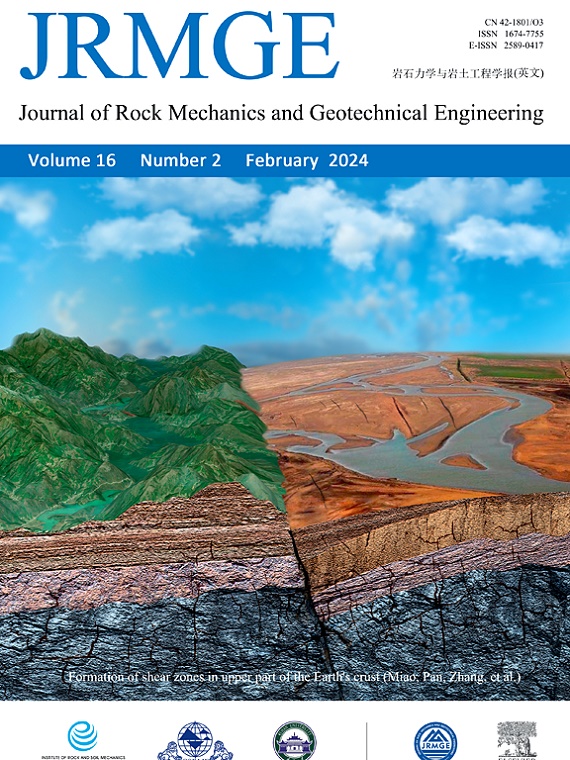花岗岩在加热和水冷过程中断裂行为的热-力耦合动力学模型
IF 10.2
1区 工程技术
Q1 ENGINEERING, GEOLOGICAL
Journal of Rock Mechanics and Geotechnical Engineering
Pub Date : 2023-11-01
DOI:10.1016/j.jrmge.2023.07.021
引用次数: 0
摘要
岩石热损伤和热破裂是地热开采项目的两个重要指标。研究了不同温度下加热和水冷却对花岗岩试样的影响。进行了室内单轴压缩实验。在此基础上,建立了热-力耦合普通状态周动力学(OSB-PD)模型和相应的数值格式,模拟了岩石在加热和冷却过程后的损伤,并预测了裂纹演化过程的变化。结果表明:加热温度升高加剧了试样的热损伤,导致花岗岩峰值强度降低,延性增加;在加载阶段,热致裂纹的逐渐发生显著影响裂纹的演化过程。数值结果准确再现了花岗岩在不同终热温度下的损伤和断裂特征,在强度、裂纹演化过程和破坏模式等方面与试验结果一致。本文章由计算机程序翻译,如有差异,请以英文原文为准。
A coupled thermo-mechanical peridynamic model for fracture behavior of granite subjected to heating and water-cooling processes
Thermal damage and thermal fracture of rocks are two important indicators in geothermal mining projects. This paper investigates the effects of heating and water-cooling on granite specimens at various temperatures. The laboratory uniaxial compression experiments were also conducted. Then, a coupled thermo-mechanical ordinary state-based peridynamic (OSB-PD) model and corresponding numerical scheme were developed to simulate the damage of rocks after the heating and cooling processes, and the change of crack evolution process was predicted. The results demonstrate that elevated heating temperatures exacerbate the thermal damage to the specimens, resulting in a decrease in peak strength and an increase in ductility of granite. The escalating occurrence of thermal-induced cracks significantly affects the crack evolution process during the loading phase. The numerical results accurately reproduce the damage and fracture characteristics of the granite under different final heating temperatures (FHTs), which are consistent with the test results in terms of strength, crack evolution process, and failure mode.
求助全文
通过发布文献求助,成功后即可免费获取论文全文。
去求助
来源期刊

Journal of Rock Mechanics and Geotechnical Engineering
Earth and Planetary Sciences-Geotechnical Engineering and Engineering Geology
CiteScore
11.60
自引率
6.80%
发文量
227
审稿时长
48 days
期刊介绍:
The Journal of Rock Mechanics and Geotechnical Engineering (JRMGE), overseen by the Institute of Rock and Soil Mechanics, Chinese Academy of Sciences, is dedicated to the latest advancements in rock mechanics and geotechnical engineering. It serves as a platform for global scholars to stay updated on developments in various related fields including soil mechanics, foundation engineering, civil engineering, mining engineering, hydraulic engineering, petroleum engineering, and engineering geology. With a focus on fostering international academic exchange, JRMGE acts as a conduit between theoretical advancements and practical applications. Topics covered include new theories, technologies, methods, experiences, in-situ and laboratory tests, developments, case studies, and timely reviews within the realm of rock mechanics and geotechnical engineering.
 求助内容:
求助内容: 应助结果提醒方式:
应助结果提醒方式:


